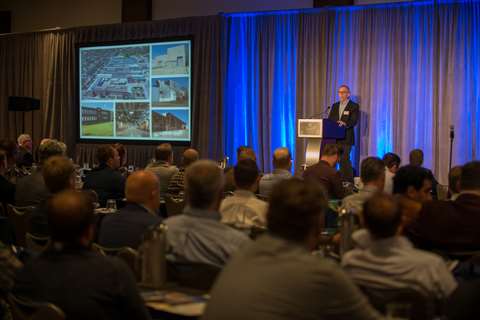10 take-aways from Jim van Nortwick’s WDS 2021 keynote
27 October 2021
GE technical expert Jim van Nortwick’s paper on the company’s brownfield programme outlines the firm’s latest operational procedures. We reveal 10 key points from his address at this year’s World Demolition Summit in Chicago.
Before GE decides anything, it gathers a lot of information.
 Jim van Nortwick of GE giving the keynote address to the World Demolition Summit 2021 in Chicago, USA
Jim van Nortwick of GE giving the keynote address to the World Demolition Summit 2021 in Chicago, USA
We look at former operations, how long they are functioning, what they produce, what kind of raw materials they have, what waste they have.
And we look at the building conditions – is a roof collapsing? Are there large bays or high bays? Is it useable now? Will it be useable with any modification?
Obviously, we look at environmental issues associated with the building materials themselves, and then the soils and the groundwaters beneath and surrounding each of these facilities. We take health and safety into concern. We ask if we clean the building to our satisfaction, so that we would want someone to reuse it if we did so?
It would be impossible to deconstruct all the sites in our portfolio at the same time
It just can’t happen because we don’t have the resources. So, like most companies we look at a lot of factors. The longer you carry a property, the more it costs you. And if you carry it for 30 years, those costs add up.
Carrying costs include real estate taxes, which is some cities can be significant. A lot of our plants and facilities in the United States are in cold climates. That means heating the building because a lot of the municipalities require you to maintain an active fire suppression system.
Most of our buildings are old plants and use wet suppression systems, and a conversion to a dry system just isn’t feasible. We also look at roof repairs, because If the roof goes, the building goes.
If maintenance costs are high, we will go ahead and tear down that building even if we don’t plan on putting the property on the market any time soon, because we can save some cost.
We consider the impact on the local community
We seek out information regarding the surrounding community and we work with them to understand their needs and we look for ways that we can assist.
For our plants in North America, we also evaluate them using the environmental justice screening tool, that US EPA developed recently. It takes demographics into account, so if you are a low-income neighbourhood, with low education or an ageing population, they rank that, and you see where there are needs you might want to fulfil.
We look at environmental issues
I don’t think I’ve seen an old manufacturing plant that hasn’t had an environmental issue. Some of these plants have been operating for 100 years and you know that the environmental regulations 100 years ago don’t resemble what we have today. In any case some of these issues can be dealt with quickly, especially if responding to a market or community need. It may cost more, but it could benefit to us to go ahead quickly.
Other environmental issues may take a longer-term solution and you may have to get the regulators involved. You may have post-sale obligations that you have to consider.
We rank and model all our sites
We do all different kinds of scenarios and rank them so that we can effectively address them. This is a wonderful tool and very useful with upper management because the output is a business plan. It’s worth its weight in gold to the finance partners, it lays out your spending year over year over year, potential income that you are going to have from the sale of a property, and costs you are going to avoid from carrying a property for 10, 20, or 30 years.
We use the traditional Request for Proposals process with contractors
We distribute the RFP with a contract and detailed technical specifications for each aspect of the project. From start to finish, from mobilisation to restoration. We also include a supplementary information package and environmental reports. We articulate our health and safety expectations, our project expectations, and some of the concerns we have regarding the project, whether they be a community issue or just a technical issue.
We will host a bid walk, again we will articulate all our CTQs, (critical to quality), we will offer additional site visits, as many as the contractor would like, within reason. We will take written questions and distribute them to the entire group of bidders. It’s only fair everybody knows what’s going on.
We encourage contractors to provide added value alternatives
We want them to give us as much detailed information regarding their approach as they can, or they feel they can. We review the bids and obviously we interview the best candidates and then we ask for their best and final offer. We will modify the contract because there is a little bit of back and forth especially in the technical specifications so we will modify the contract to accommodate that. The contract is the contract, at that point the supplementary information on the side goes away because we put everything in the contract.
Typically, we solicit bids from four or five contractors at once. These are pre-vetted, based on their safety performance. We will also look at their reputation and then we check into the GE contractor database. We measure everything. If I’m going to go is look in the database. It could be that my experience with a particular contractor was great, years ago, but something happened. And we are such a big company I can’t rely on word of mouth.
Recently we have been bidding jobs in bundles
We will put six or seven jobs, sometimes in different regional areas, and put them all together in one package. It’s tough when the contractor goes on seven bid walks and they take a day each, it’s a big effort, but it’s working well for us, and I think it’s working out well for the winning companies.
We use the environmental service contract to manage the contractors
If I go on a site, and I see the binder up on the shelf, nice and neat, I get angry. I don’t like that. I want to see that environmental services contract. It has everything in it, it is the roadmap for the contractor’s success. I want to see it dog-eared, dirty, and on the table, that’s very important to me.
We have worked on the contract for a long time, and we use the same terms in our alliance partnership agreements and some of our master service agreements, so I think it’s logical, it flows, and it makes for a quick legal review. Most of the time we will talk to your attorney, and they will have some good points that we will incorporate that in the next version of the environmental services contract. Estimators on the other hand will probably have to spend a long time looking at the technical specifications, which are predominantly performance based.
During the interview process we will probably ask you about your means and methods, and your approach to a certain situation. We require you to have a full time, on-site dedicated safety manager spending no time on production but 100% of time on safety. During deconstruction, we want contractors to have tailgate meetings once, maybe twice a day. Then we want weekly meetings,
I need to see photographs; I need to know what’s going on. I can’t be on the site every day, so we must have an idea of what you are doing, and photographs tell a pretty good story.
Everyone working on the project can identify opportunities for improvement
If you are not looking for something that you can improve on, then you are not being safe. It’s important to us that if there is an opportunity for improvement on a particular task, please bring it forward every day, however small you think it might be.
And then we also stress that every worker, every person, whether it be my construction manager, or any of the workers on site, they have the right to exercise ‘stop work’.
That is extremely important for us – if you see something unsafe, stop it.
- Jim van Nortwick was speaking at the World Demolition Summit, which took place in Chicago, USA, on 20 and 21 October. The WDS is organised by Demolition & Recycling International (D&Ri) in cooperation with the European Demolition Association and the US National Demolition Association. For more coverage, please see the Nov-Dec issue of D&Ri published next month. To view individual conference presentations, please visit https://khl-events.com/Demolition/Demolition-Summit
MAGAZINE
NEWSLETTER
CONNECT WITH THE TEAM






